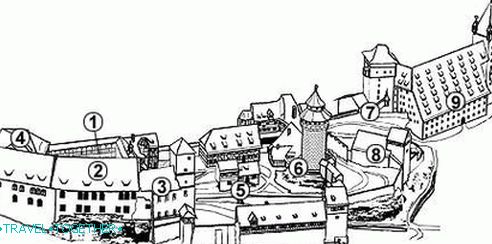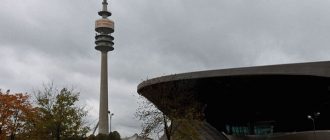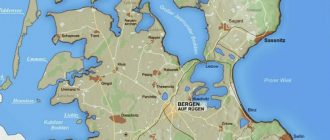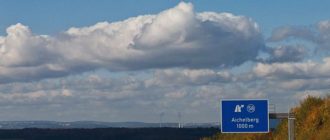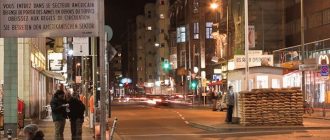Nuremberg (Germany) – the most important attractions with photos and description. Detailed information about the city and interesting routes Nuremberg on the map.
Contents
- 1 City of Nuremberg (Nürnberg )
- 2 Story
- 3 Useful information for tourists
- 4 How to get to Nuremberg?
- 5 Accommodation
- 6 Shopping and shopping
- 7 Interesting seasonal markets of Nuremberg
- 8 Museums of Nuremberg
- 9 Kitchen and food
- 10 Sights of Nuremberg
- 10.1 Imperial Castle -Kaiserburg
- 10.2 Church of sv. Sebald -St. Sebald
- 10.3 Cathedral of sv. Lorentz -St. Lorenz
- 10.4 Frauenkirche (Church of Our Lady) -Frauenkirche
- 10.5 Beautiful Fountain – Schöner Brunnen
- 10.6 Albrecht Dürer’s House -Albrecht-Dürer-Haus
- 10.7 Old Town Hall -Altes Rathaus
- 10.8 Pegnitz River Embankment
- 11 Church of sv. Clara – St. Klara
- 12 Interesting routes around Nuremberg and main attractions on the map
- 13 Nuremberg on the map
City of Nuremberg (Nürnberg )
Nuremberg is a city in Germany located on southeast of the country in the federal state of Bavaria on the shores of a small River Pegnitz. This is a city with almost a thousand years of history, a city toys, gingerbread, Bavarian sausages, as well as interesting attractions. Nuremberg is the second largest population after Munich. It has almost half a million inhabitants. Nuremberg is one of the most economically developed in Germany and enters the TOP 25 cities of the world with the highest standard of living.
- Story
- Useful information for the tourist
- How to get to Nuremberg?
- Accommodation
- Shopping and shopping
- Interesting seasonal markets of Nuremberg
- Museums of Nuremberg
- Kitchen and food
- Sights of Nuremberg
- Interesting routes around Nuremberg and main attractions on the map
Nuremberg is often called the capital of Northern Bavaria. And this is the title he wears quite rightly. It is a major cultural tourist and economic center of the whole Southeast Germany.
 Streets Old Town
Streets Old Town
Story
The beginning of the history of the city are considered the first written about him, dating from 1050 year. At this time on a rocky cliff above Pegnitz river was built castle-fortress Norenberc. It is believed that the name of the city comes from the word Nor, which means (stone cliff).
Favorable location ensured the prosperity of Nuremberg, and The fortress became the residence of the German kings. And King Conrad II built a royal court on the left bank of the river (historic district city center).
 Panorama of Nuremberg
Panorama of Nuremberg
At the beginning of the 12th century, the castle and settlement suffered from conflict. King Henry IV and his son Henry V. The castle was transferred to possession of the nobles nam Raabs. In the first half of the 12th century, the king Conrad III began the expansion of the castle, which was completed in 1180 the year by Emperor Frederick I Barbarossa, who made him imperial residence.
In the 13th century, the value of the city begins to grow and increase. One of the reasons is also a religious component. AT The neighborhood of Nuremberg lived and died a hermit of St.. Sebald In honor of It was built the first large church of the city, in which put his relics.
At the beginning of the 15th century, Emperor Sigismund issues a decree according to which imperial regalia will forever be stored in Nuremberg. So occurred until the end of the 18th century, while threatened by the invasion of the French they were not transported to Vienna.
 The historic center of Nuremberg
The historic center of Nuremberg
The 15th and 16th centuries were very successful for the city. Nuremberg not only gaining influence, but growing and thriving. Here develop trade, crafts, science. Famous artists come to the city and scientists.
This continued until the beginning of the 17th century, when it began Thirty Years War. Nuremberg, while maintaining neutrality, chose the buy-out strategy that made the city a debtor and substantially slowed its economic growth.
The 18-19 centuries marked an industrial boom. In Nuremberg started to build factories and manufactories, the first German railway connected the city with Fürth. At the end of the 19th century, the population of the city exceeded 100 thousand people.
 Nuremberg – evening
Nuremberg – evening
In the early 20th century, Nuremberg became one of the ideological centers of racism. In 1927, the first congress takes place here. National Socialist Workers Party.
The Second World War leaves a terrible mark on the “face” of the city. AT the bombing resulted in the destruction of 90% of the Old Town, which managed to recover only in 1966.
In 1945-1949, the Nuremberg trials took place in the city – the court over the leaders of nazism.
Useful information for tourists
- Movement around the city. Nuremberg city is quite compact. It is convenient to walk on the historical center. if you love bicycles, you will find about 70 stations for their rental. Public transport is represented by buses, subways and trams. Interestingly, in 2008 there was completely introduced here. automatic metro line.
 Scheme public transport Nuremberg
Scheme public transport Nuremberg
- Tourist information centers are located as follows Königstraße 93 90402 Nürnberg and Hauptmarkt 18 90403 Nürnberg
- Tourist tax in Nuremberg is not charged.
How to get to Nuremberg?
Nuremberg has a large international airport, flights to which is from most major cities of Russia and the CIS.
From other cities in Germany and Europe in Nuremberg can be reached by train and bus. You can see the schedule and buy tickets here -https: //www.bahn.de/p/view/angebot/index.shtml
Accommodation
Finding accommodation in Nuremberg is not difficult if take care of this in advance. Here there is a big the number of hotels, guesthouses and apartments of different price groups. For budget travelers operates hostels. Because Bavaria alone of the most expensive to visit in Germany, then the prices of accommodation and food here is slightly higher than the average in Germany, and if compare with the neighboring Czech Republic and Poland, the difference is very significant.
Shopping and shopping
Nuremberg is a great opportunity for shopping. Here you You will find many shops where you can buy souvenirs, clothes and much more.
Large shopping centers of Nuremberg on the map
Especially noteworthy is the largest shopping center. Nuremberg – Franken-Center Nürnberg, in which more 100 stores, including discounts.
Especially noteworthy is the largest shopping center. Nuremberg – Franken-Center Nürnberg, in which more 100 stores, including discounts.
Also in Nuremberg, a large number of farm markets with relatively inexpensive and fresh products, vegetables and fruits
Interesting seasonal markets of Nuremberg
Very interesting are the seasonal markets of Nuremberg, which are not known only in Germany, but also outside of it:
- Christmas market from December 1 – held in the old center cities.
- Easter Markets March 31 to April 17, 2017 – Easter decorations, dishes, food, etc.
- The largest flea market in Germany from 12 to 13 May – a lot interesting things antiques.
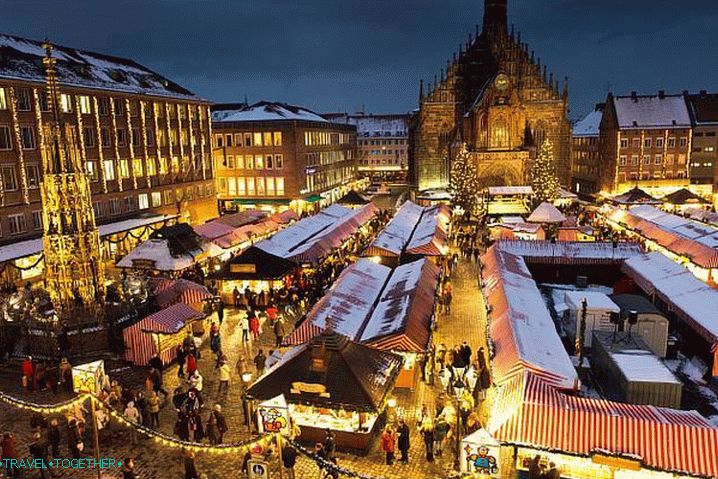 Christmas Market in Nuremberg
Christmas Market in Nuremberg
Museums of Nuremberg
For lovers of museums, Nuremberg will definitely like it. Here they are just great amount. Here are the largest and most interesting of them:
- German National Museum – Kartäusergasse 1 D-90402 Nürnberg. Open Tuesday – Sunday from 10 – 18, Wednesday from 10-21 evenings
- Imperial Castle Nuremberg – Auf der Burg 13 90403 Nürnberg. Works April-September: from 9-18 o’clock, October to March from 10-16 hours.
- Natural History Museum – Marientorgraben 8 90402 Nürnberg. Open from Monday to Thursday and Sunday from 10-17 hours, Friday from 10-21 hours.
- Toy Museum – Karlstraße 13-15 90403 Nürnberg. Work with Tuesday to Friday from 10 to 17 hours, weekends from 10 to 18 hours
Kitchen and food
In Nuremberg you will find many restaurants with regional, European and Eastern cuisine, as well as all known networks fast food Regional cuisine is represented by dishes from the Bavarian and Franconian cuisine.
Soups:
- Fränkische Hochzeitssuppe
- Fränkische Metzelsuppe
- Fränkische Sauerampfersuppe
- Leberklößsuppe
- Petersiliensuppe
- Bohnensuppe
- Aischer fischsuppe
Snacks and salads
- Ziebeleskäs
- Fränkische Wurst- oder Bratwurstsülze
- Nürnberger Bratwurstzwiebel
- Stadtwurst mit musik
- Ochsenmaulsalat
- Nürnberger Gwerch – Wurstsalat auf Nürnberger Art
- Pressack mit musik
- Nackerte (Bratwurstgehäck)
- Bauernseufzer (geräucherte Bratwurst roh oder warm)
Dessert
- Apfelkiechla (Apfelkrapfen)
- Gebackene holunderblüten
- Versoffene jungfrau
- Karthäuser klöße
- Kirschenmännla
- Knieküchle
What you need to try:
- Lebkuchen – Nuremberg gingerbread
- Bratwürste – sausages
Restaurants with regional cuisine
The most popular drink is beer. The most marked on the map best beer:
The most popular drink is beer. The most marked on the map best beer:
Sights of Nuremberg
Nuremberg has a large number of interesting attractions – ancient cathedrals and historic buildings, impressive imperial castle and more.
Imperial Castle -Kaiserburg
On a steep sandstone cliff above the city Nuremberg is one of its main attractions. -Kaiserburg or Imperial Castle. This is one of the most important. castles of the Holy Roman Empire, the oldest part of which refers to the year 1200. He played a huge role in history. cities and the whole German nation.
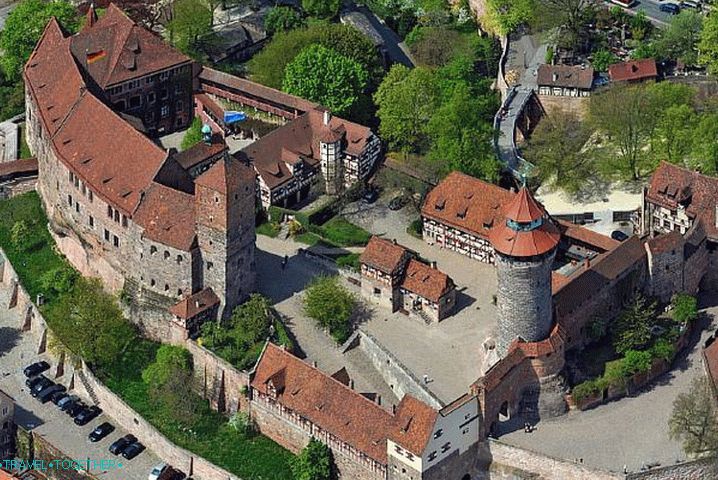
The first written mention of the castle dates back to 1050. Already in The 12th century castle turns into an imperial residence, is being built and expands.
In the late Middle Ages, Nuremberg turns into one of the most important and influential cities of the Empire. Charles IV ruled that each newly elected emperor must hold his First Reichstag (the highest estate representative body of the Sacred Roman Empire). This tradition persisted until the second half of the 17 century.
In the first half of the 15th century, Emperor Sigismund decided to keep the imperial regalia in Kaiserburg as a sign special trust.
At the beginning of the 19th century, when the Sacred The Roman Empire, the city became part of the Bavarian Kingdom, and The castle became a monument to German history.
During the Second World War, the castle was almost completely destroyed, although many Romanesque and Gothic elements are preserved almost intact.
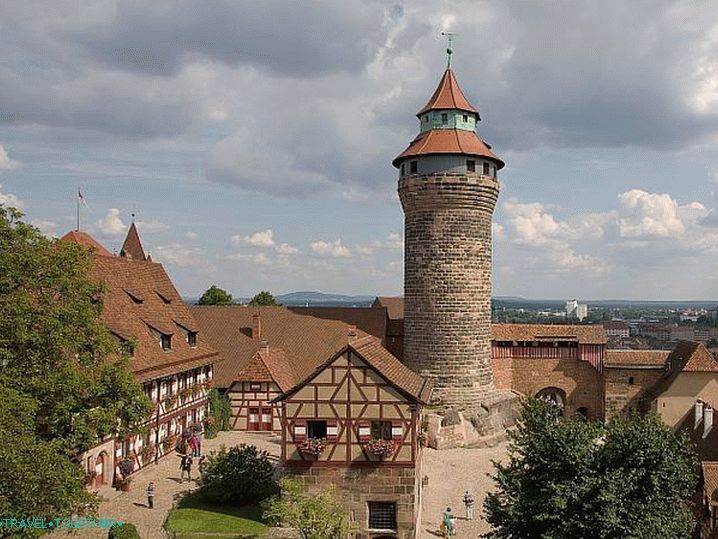 View on Kaiserburg
View on Kaiserburg
The Imperial Castle in Nuremberg is one of the largest locks in germany. It is a closed loop system with three gates and powerful walls.
The scheme of the Imperial Castle
Sights and places of interest:
1 Courtyard 2 Palace – two floors buildings with living rooms and halls. Was built on the foundation of the previous 12th century buildings. 3 Chapel – adjacent to the building Palace.4 Museum-here are interesting exposure of weapons, armor, astronomical instruments, as well as things related to the life and history of Nuremberg.5 Deep Well – building was built in 1563. The well has a depth of 50 meters.6 Tower Synvelturm – a 13th century tower with a beautiful view of the Old city. Used as a military dungeon to detect enemy.7 Pentagonal Tower8 Capella9 Stables10 Watch tower
Mode of operation of the castle: April-September: from 9 to 18 hours, October to March: from 10 to 16 hours, daily.
Church of sv. Sebald -St. Sebald
Church of sv. Sebald – the oldest church in Nuremberg, which Begins its history in the 13th century. The current church building was built in 1480. This is a beautiful medieval gothic church dedicated to sv. Sebald – a hermit who lived in the forest near Nuremberg in the 8th century. Here, according to legend, it is stored power
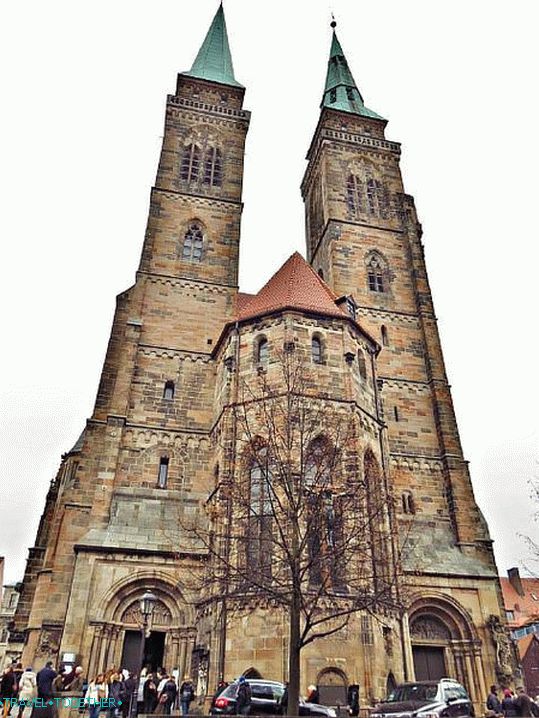 Church of sv. Sebald in Nuremberg
Church of sv. Sebald in Nuremberg  Interior of the Cathedral of Sts. Sebald
Interior of the Cathedral of Sts. Sebald
Cathedral of sv. Lorentz -St. Lorenz
Cathedral of sv. Lorenz – medieval gothic church, built around 1250. This is one of the masterpieces of Gothic and most beautiful cathedrals of Nuremberg.
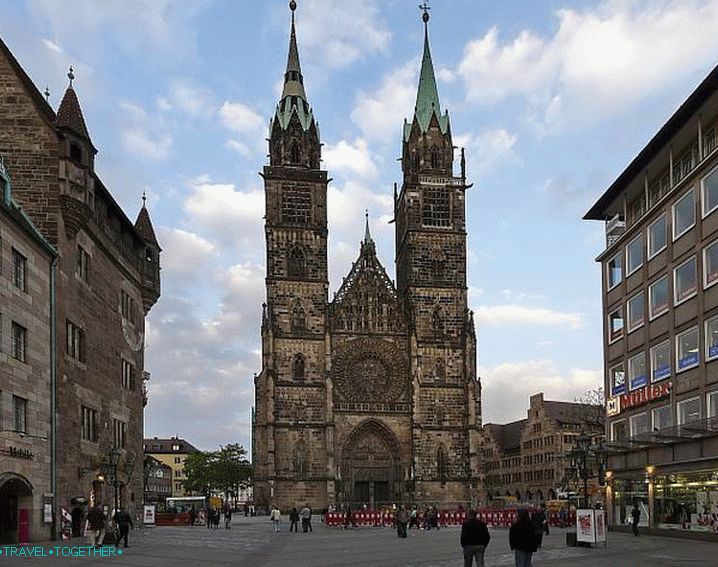 Church of sv. Lorenz
Church of sv. Lorenz
Church of sv. Lorenz is a high three basilica, one of two great protestant churches Nuremberg. The height of the towers is more than 80 meters. Church also includes a bell tower with 16 bells.
The interior of the church is the masterpieces of the Gothic and Middle Ages: the tabernacle, altar, sculptures and frescoes.
Near the cathedral is locatedNassau House (Nassauerhaus) – medieval gothic house-tower.
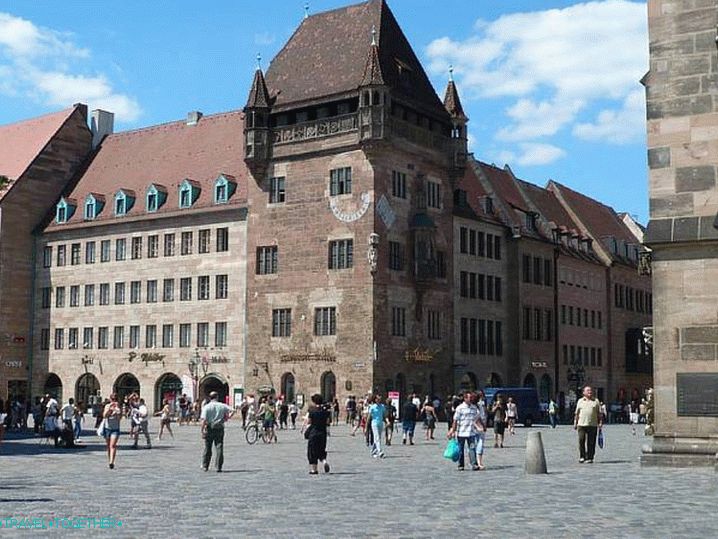 House Nassau
House Nassau
Frauenkirche (Church of Our Lady) -Frauenkirche
Frauenkirche – one of the most famous and beautiful churches Nuremberg, and probably the whole of Germany. Located in the heart Old Town in the eastern part of the market square.
This is a medieval Gothic church, built in the 14th century.
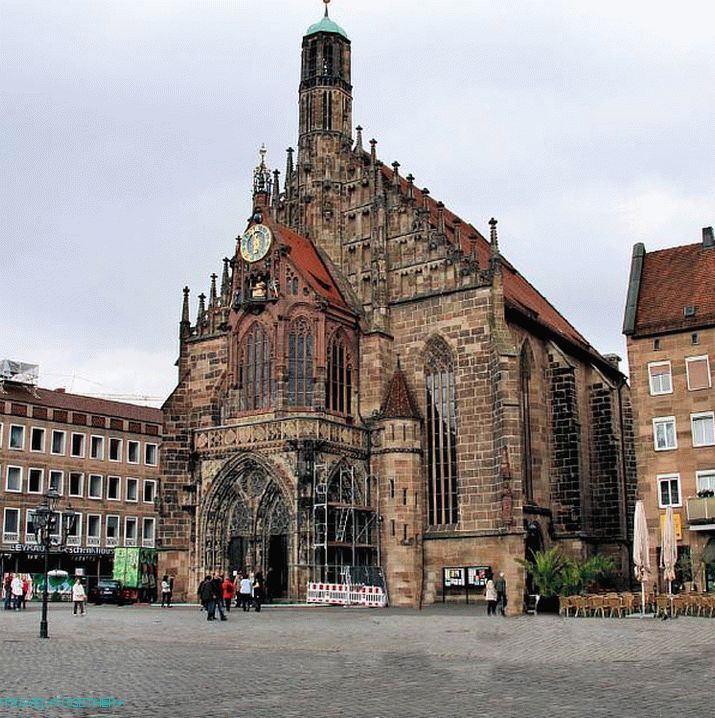 Frauenkirche (Church of Our Lady)
Frauenkirche (Church of Our Lady)
The facade of the church is decorated with an astronomical clock of the beginning of the 16th century.
 Astronomical clock
Astronomical clock
Inside the Frauenkirche numerous works of art are collected since the Middle Ages.
Beautiful Fountain – Schöner Brunnen
Medieval fountain built at the end of the 14th century on market square. The height of this structure is about 19 meters. Fountain has the shape of a gothic spire. Throughout history, the fountain was restored several times. After a long renovation in Currently, the fountain is open and pleases many tourists.
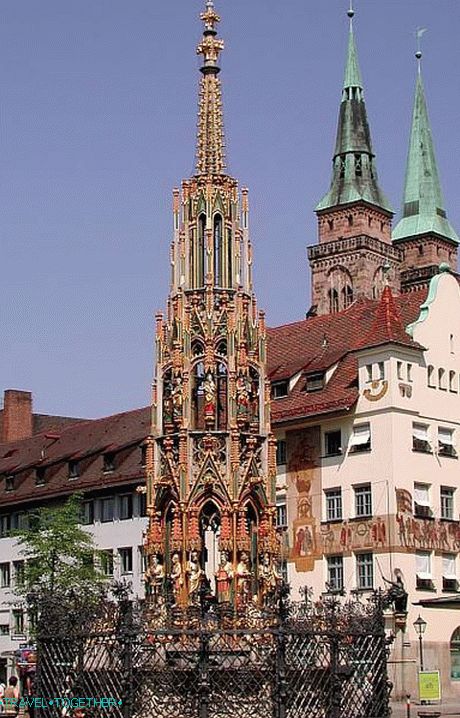 Beautiful fountain
Beautiful fountain
Albrecht Dürer’s House -Albrecht-Dürer-Haus
Albrecht Dürer’s House is a beautiful house from the late Middle Ages. In this house in the 15th century there lived a famous artist, one of the greatest masters of the Western European RenaissanceAlbrecht Dürer Now there is a museum and exhibition of graphics and painting
 House Albrecht Durer
House Albrecht Durer
Old Town Hall -Altes Rathaus
The Old Town Hall is a building in the historic center of Nuremberg, built in the 16th century. This is one of the attractions of the Old cities. Town Hall is a masterpiece architecture. It was destroyed in the second world war, later restored.
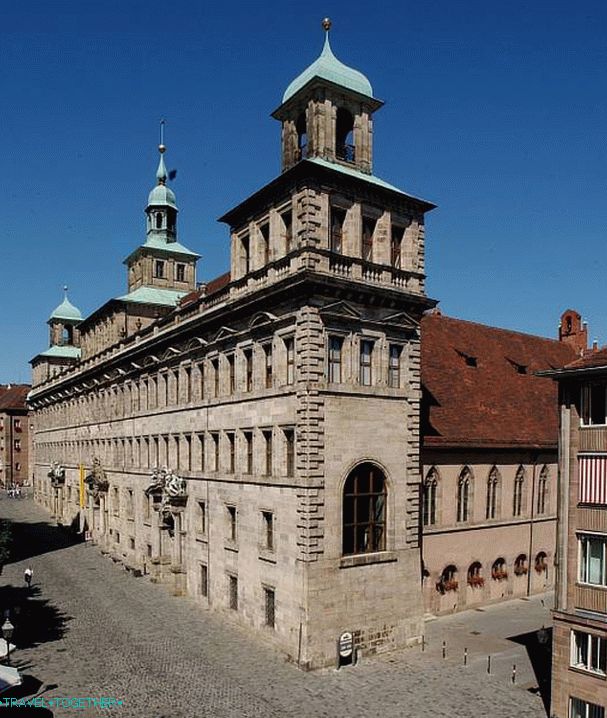 Old Town Hall
Old Town Hall
Pegnitz River Embankment
The historic district of Nuremberg, in which the ancient historical buildings and structures.
- Old arched sandstone bridge built in the 15th century.
- The wine shed (Weinstadel) is a building built in the 15th century, one of the most important monuments of the Old Town Nuremberg. One of the largest half-timbered buildings in Germany. Beside there is an old water tower. The name comes from its functions as a city wine warehouse.
- This area has an old wooden bridge (Henkersteg), built in the 15th century. Throughout its history, it was repeatedly exchanged, after the second world war was restored.
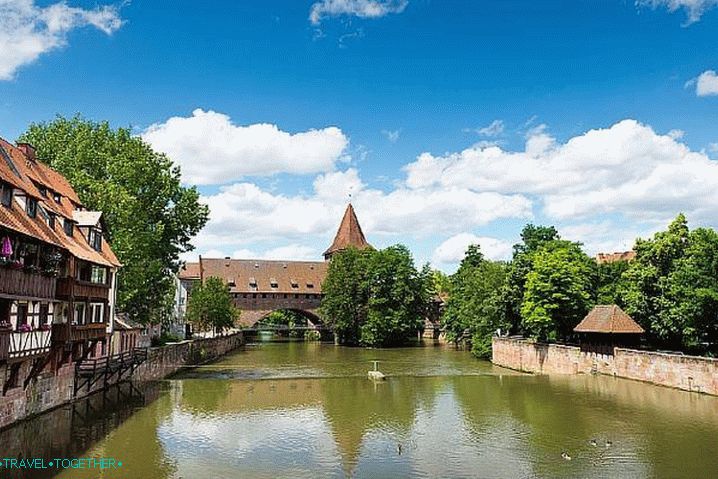 Pegnitz River Embankment
Pegnitz River Embankment
Church of sv. Clara – St. Klara
Church of sv. Clara – one of the oldest churches in Nuremberg, built in the old part of the city. Church building started in 1270. This is one of the iconic religious buildings, originally serving the convent of klarisok. Architectural style – Gothic with romance elements. Exterior walls are made of them. sandstone. The interior of the church is strict and ascetic.
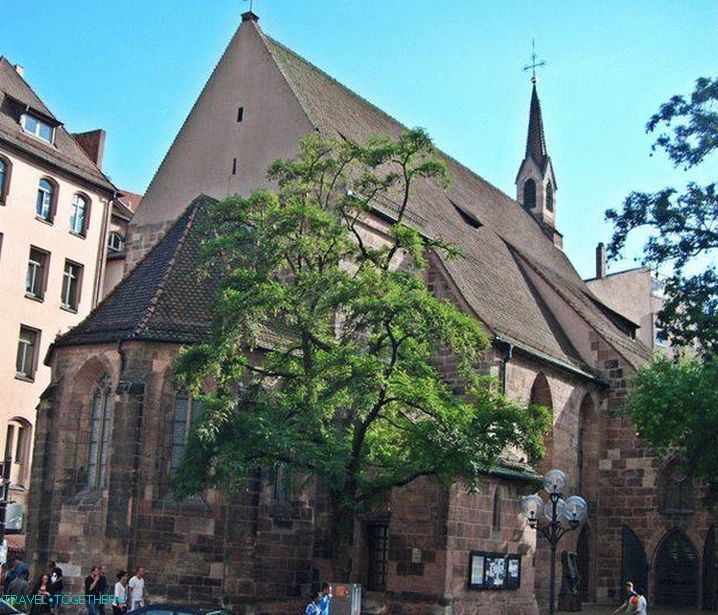
Church of sv. Martha -St. Martha
Church of sv. Martha is a building in the southeast of the old city, lurking between two houses. The history of the church dates back to the 14th century. This is a beautiful gothic building. The church was badly damaged in 2014 during a strong fire and recently restored.
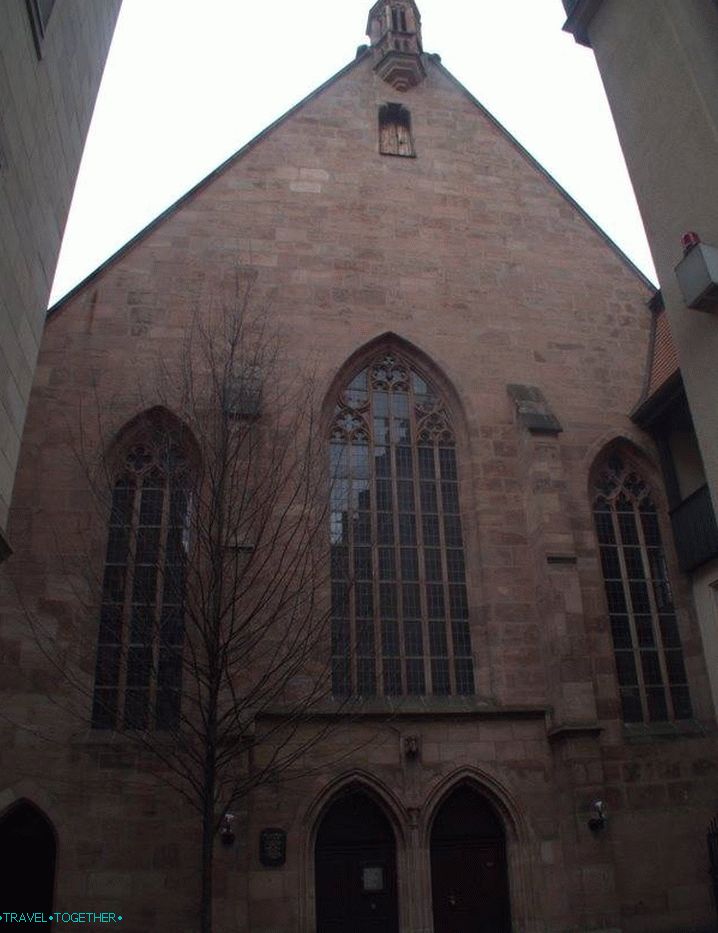 Church of sv. Martha -St. Martha
Church of sv. Martha -St. Martha
Nuremberg City Walls -Stadtmauer
City walls are among the main artistic and architectural monuments of Nuremberg. This is a powerful defensive fortifications that encircle the old town and are adjacent to the castle. The first fortifications in Nuremberg appeared in the 11th century. In the 13th century Fortifications have already emerged on both sides of the Pegnitz River. Interesting that in the history of Nuremberg was taken only once – in 1945 during World War II.
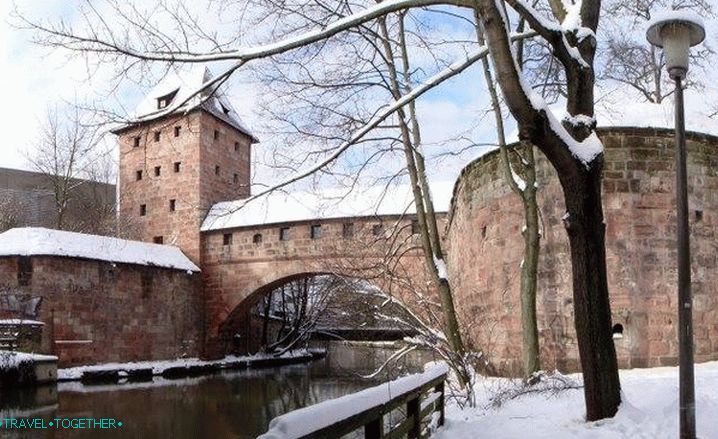 Nuremberg city walls
Nuremberg city walls
At the beginning of the 15th century, the wall acquired the form kosogoparallelogramm, in the corners of which was placed four towers The walls were surrounded by a dry moat excavated during the Hussite wars
 White Tower
White Tower
5 main gates led to the city, 2 pedestrian crossings, also The gates were equipped with four towers.
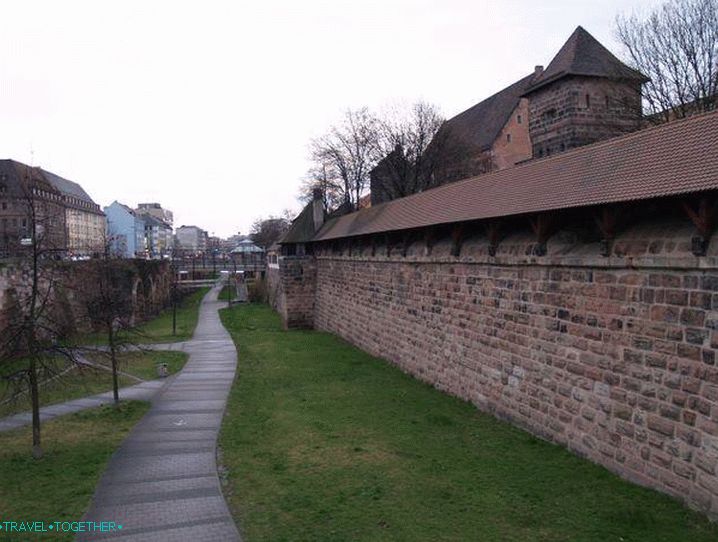 Nuremberg city walls
Nuremberg city walls
Currently, the city wall is almost completely preserved and surrounds the old town.
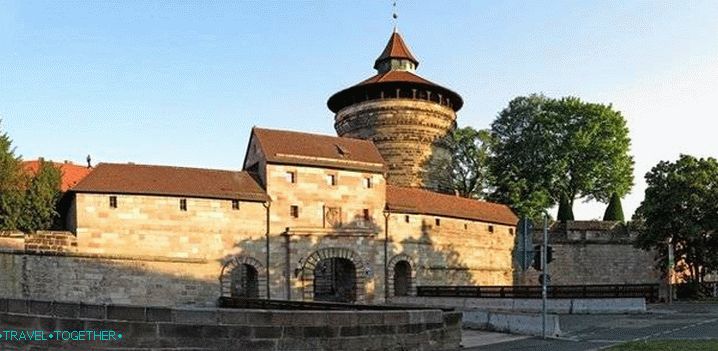 Middle Tower – Neutor Tower
Middle Tower – Neutor Tower
Historic Building – Mauthalle
Mauthalle (literally from the German assembly hall) – interesting medieval historic building in the old city center, built at the end of the 15th century. In total 12 storage facilities provided citizens of Nuremberg with products during crisis and military action. Currently the building performs commercial functions.
 Historic Building – Mauthalle
Historic Building – Mauthalle
Debt Prison -Schuldturm
Debt Prison – a medieval tower in Nuremberg, built in 14th century, part of the city wall. This is one of the surviving towers. Old Town. After the walls were built, it was turned into a prison.
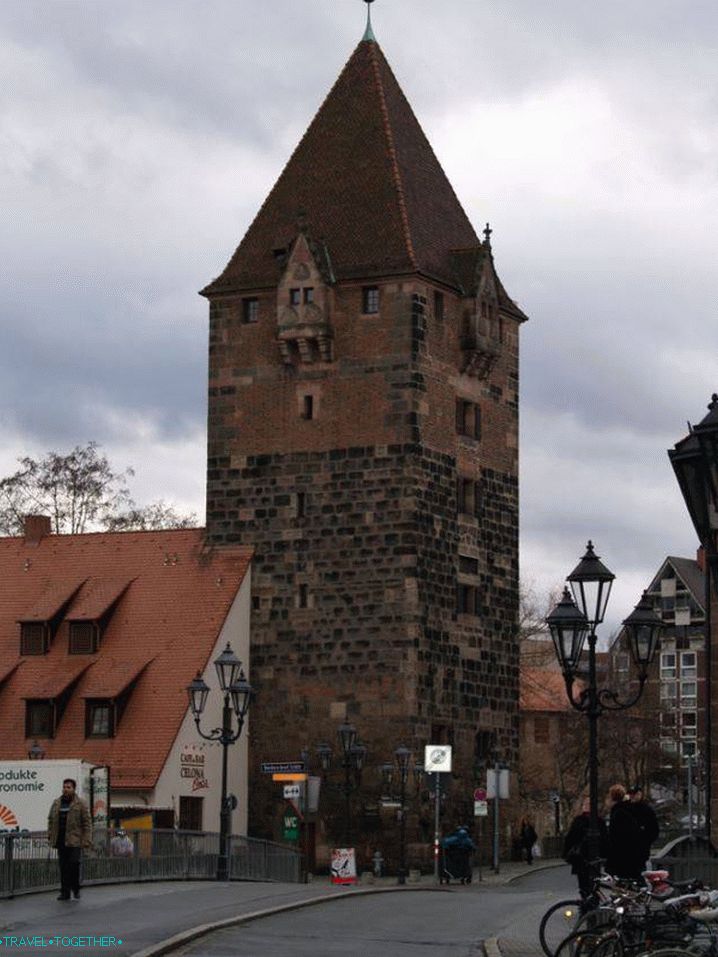 Debt Prison -Schuldturm
Debt Prison -Schuldturm
Castle Tucher -Tucherschloss
Historic building in the old town of Nuremberg, built in first half of the 16th century. This is the city palace of Nuremberg Tucher patrician family. The building is a three-storey building of sandstone blocks, made in style of the French Renaissance. Now located here Museum of the history of the family.
 Castle Tucher -Tucherschloss
Castle Tucher -Tucherschloss
House Pilate -Pilatushaus
One of the few remaining houses from the late period Gothic in Nuremberg. This historic building is located near from the Nuremberg Castle. The house was built in the late 15th century. AT currently used for contemporary exhibitions art.
 House Pilate -Pilatushaus
House Pilate -Pilatushaus

